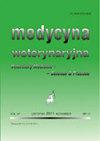胰高血糖素样肽1 (GLP-1)在哺乳动物消化道中的分布和功能及其类似物的临床应用
IF 0.4
4区 农林科学
Q4 VETERINARY SCIENCES
Medycyna Weterynaryjna-Veterinary Medicine-Science and Practice
Pub Date : 2023-01-01
DOI:10.21521/mw.6374
引用次数: 1
摘要
最近,人们对胰高血糖素样肽-1 (GLP-1)和其他胰高血糖素前体衍生的肽的兴趣显著增加。GLP-1是l型肠内分泌细胞对食物摄入产生的一种含有30个氨基酸的肽激素。在激素离开肠道之前,GLP-1被二肽基肽酶IV酶迅速代谢和失活,这增加了GLP-1作用通过肠道和肝脏的感觉神经元通过GLP-1受体传递的可能性。GLP-1的主要作用是刺激胰岛素分泌(即作为促肠促胰岛素激素)和抑制胰高血糖素分泌,从而有助于减少餐后血糖峰值。GLP-1也抑制运动和胃肠道分泌,因此作为“小肠制动”机制的一部分。GLP-1似乎也是食欲和食物摄入的生理调节剂。由于这些作用,GLP-1或GLP-1受体激动剂现在越来越多地用于治疗2型糖尿病。GLP-1分泌减少可能导致肥胖的发生,分泌过多可能导致餐后反应性低血糖。GLP-1激动剂的使用为治疗2型糖尿病和其他代谢性疾病开辟了新的可能性。在过去的二十年中,许多有趣的研究涵盖了GLP-1的生理和病理生理作用,并且我们对GLP-1的理解有了显着的扩展。在这篇综述文章中,我们试图描述我们目前对GLP-1在健康和疾病中作为外周激素和中枢神经递质的理解。结合目前的研究,重点介绍了其对人体的生物学作用和潜在的临床应用。本文章由计算机程序翻译,如有差异,请以英文原文为准。
Distribution and function of glucagon-like peptide 1 (GLP-1) in the digestive tract of mammals and the clinical use of its analogues
Recently, interest in glucagon-like peptide-1 (GLP-1) and other peptides derived from preproglucagon has increased significantly. GLP-1 is a 30-amino acid peptide hormone produced in L-type enteroendocrine cells as a response to food intake. GLP-1 is rapidly metabolized and inactivated by the dipeptidyl peptidase IV enzyme before the hormone leaves the intestine, which increases the likelihood that GLP-1 action is transmitted through sensory neurons in the intestine and liver through the GLP-1 receptor. The main actions of GLP-1 are to stimulate insulin secretion (i.e. act as incretin hormone) and inhibit glucagon secretion, thus contributing to the reduction of postprandial glucose spikes. GLP-1 also inhibits motility and gastrointestinal secretion, and therefore acts as part of the „small bowel brake” mechanism. GLP-1 also appears to be a physiological regulator of appetite and food intake. Because of these effects, GLP-1 or GLP-1 receptor agonists are now increasingly used to treat type 2 diabetes. Reduced GLP-1 secretion may contribute to the development of obesity, and excessive secretion may be responsible for postprandial reactive hypoglycemia. The use of GLP-1 agonists opens up new possibilities for the treatment of type 2 diabetes and other metabolic diseases. In the last two decades, many interesting studies covering both the physiological and pathophysiological role of GLP-1 have been published, and our understanding of GLP-1 has broadened significantly. In this review article, we have tried to describe our current understanding of how GLP-1 works as both a peripheral hormone and as a central neurotransmitter in health and disease. We focused on its biological effects on the body and the potential clinical application in relation to current research.
求助全文
通过发布文献求助,成功后即可免费获取论文全文。
去求助
来源期刊

Medycyna Weterynaryjna-Veterinary Medicine-Science and Practice
VETERINARY SCIENCES-
CiteScore
0.80
自引率
0.00%
发文量
73
审稿时长
4-8 weeks
期刊介绍:
"Medycyna Weterynaryjna" publishes various types of articles which are grouped in the following editorial categories: reviews, original studies, scientific and professional problems, the history of veterinary medicine, posthumous memoirs, as well as chronicles that briefly relate scientific advances and developments in the veterinary profession and medicine. The most important are the first two categories, which are published with short summaries in English. Moreover, from 2001 the editors of "Medycyna Weterynaryjna", bearing in mind market demands, has also started publishing entire works in English. Since 2008 the periodical has appeared in an electronic version. The following are available in this version: summaries of studies published from 1999 to 2005, full versions of all the studies published in the years 2006-2011 (in pdf files), and full versions of the English studies published in the current year (pdf). Only summaries of the remaining studies from the current year are available. In accordance with the principles accepted by the editors, the full versions of these texts will not be made available until next year.
All articles are evaluated twice by leading Polish scientists and professionals before they are considered for publication. For years now "Medycyna Weterynaryjna" has maintained a high standard thanks to this system. The review articles are actually succinct monographs dealing with specific scientific and professional problems that are based on the most recent findings. Original works have a particular value, since they present research carried out in Polish and international scientific centers.
 求助内容:
求助内容: 应助结果提醒方式:
应助结果提醒方式:


